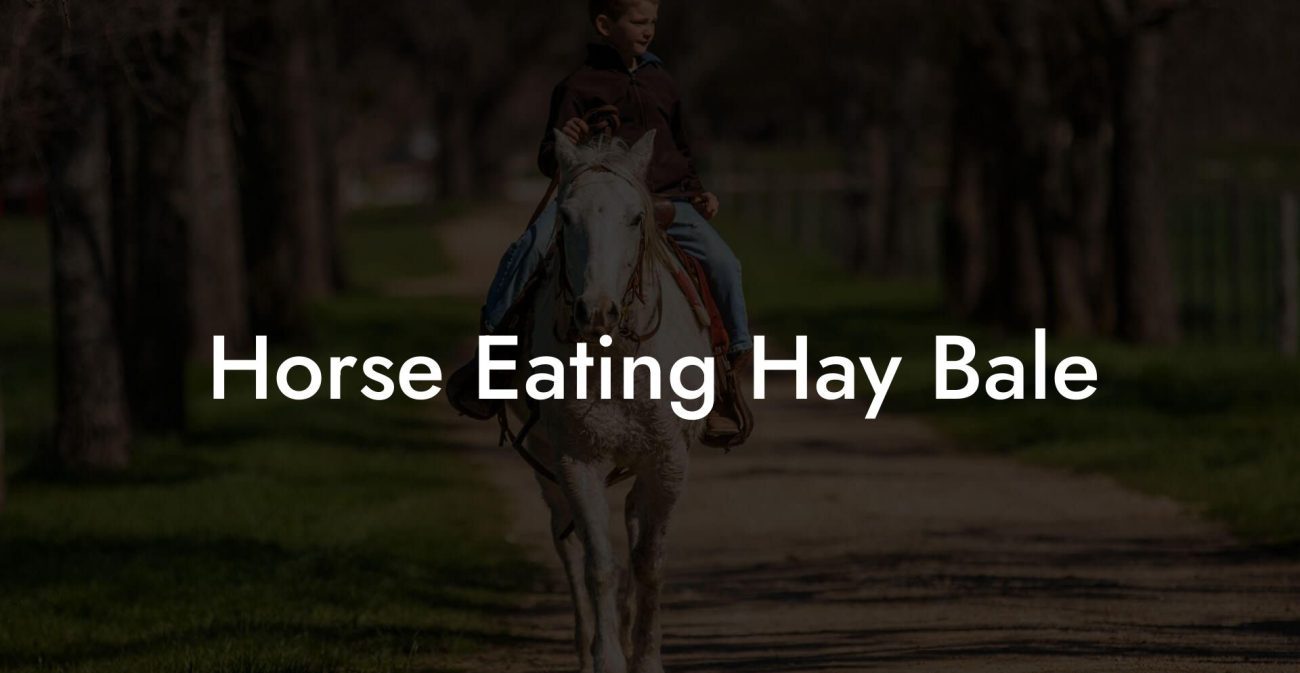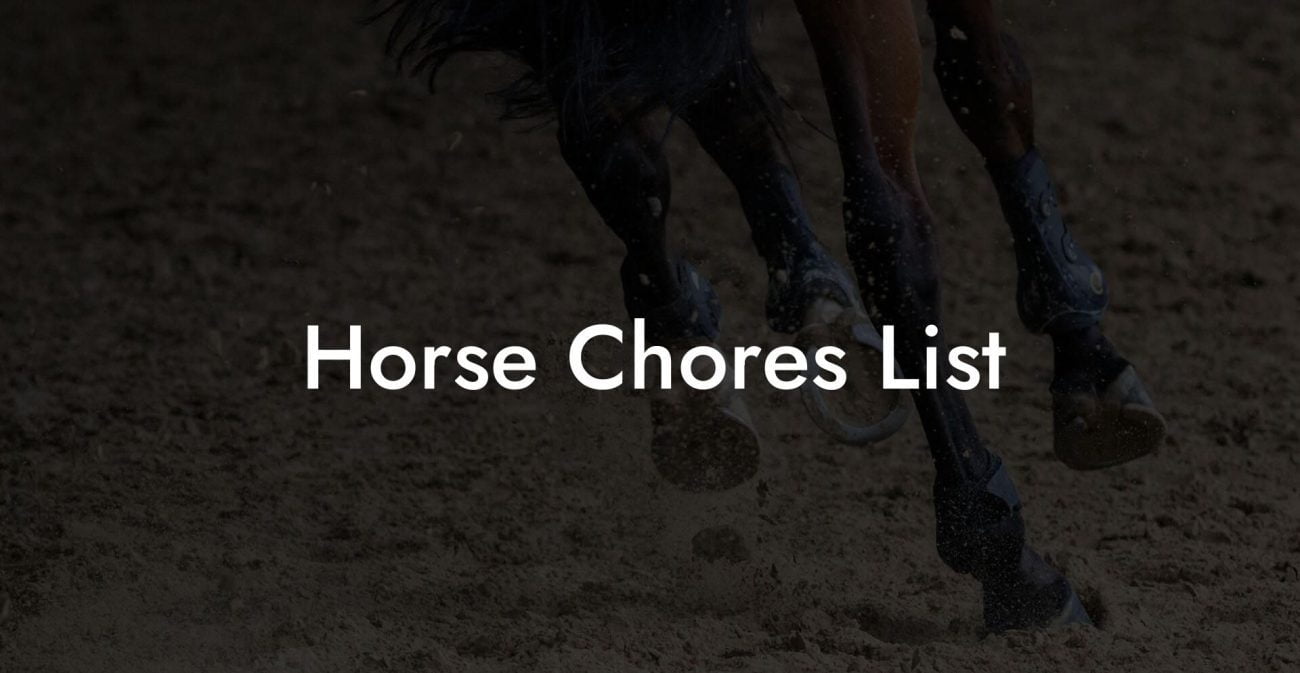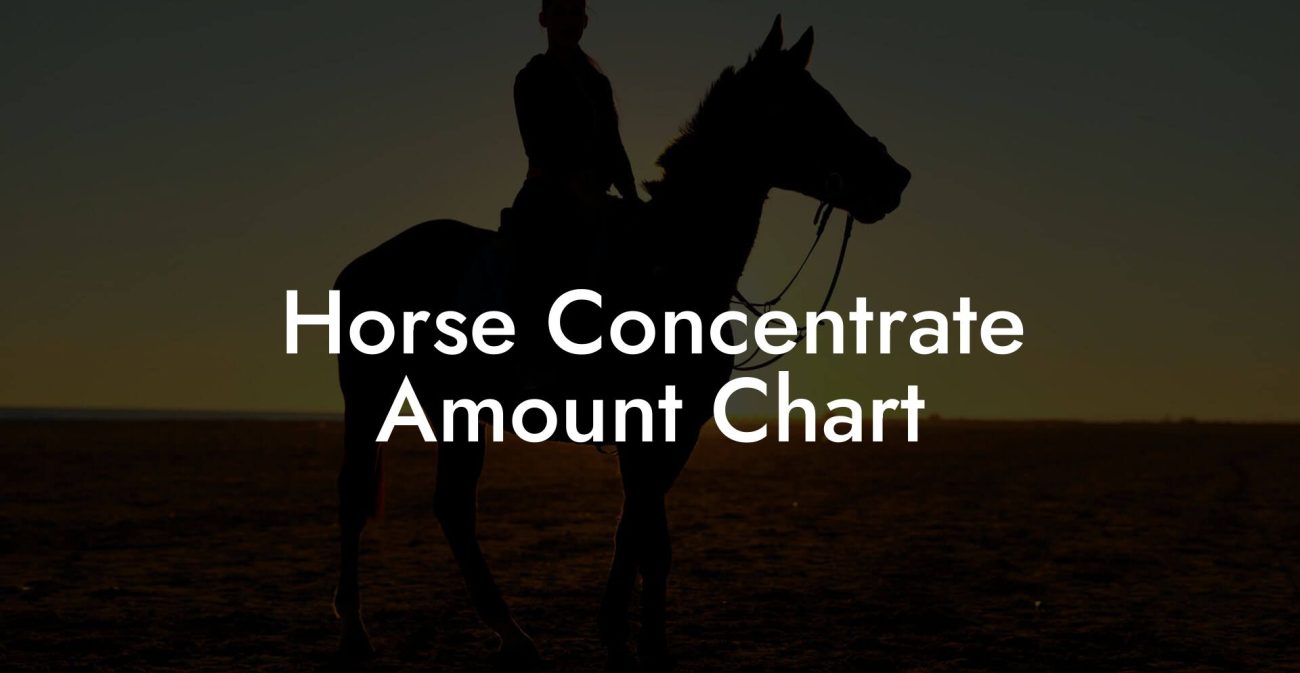Ever found yourself scrolling through memes on your phone and thinking, “I wish I had a horse that could just chill in a field of luscious hay, all while living its best life”? Well, saddle up, because “Hay Horses” isn’t just a quirky phrase, it’s a deep dive into creating the ultimate care and lifestyle guide for your equine friend. In today’s modern, sometimes chaotic world, caring for your horse isn’t just about routines and feed buckets; it’s an art form that blends science, sustainability, and a pinch of millennial-style humor. Whether you’re a newbie equestrian or a seasoned rider looking to optimize your stable’s vibe, this guide is crafted to deliver top-tier, engaging insights on how to care for your horse like a boss.
Quick Links to Useful Sections
- Hay Horses: A Harvest of health for Your Equine Companion
- The Role of Quality Hay in Equine Nutrition
- Choosing the Right Hay: Appearance, Texture, and Nutritional Benefits
- Advanced Feeding Practices: Timing, Portions, and Variety
- Environmental Considerations: Creating a Clean, Comfortable Stable
- Grooming, Training, and Bonding: The Heart of Equine Care
- Health and Wellness: Monitoring Your Horse’s Vital Signs
- Modern Technologies and Tools for Equestrian Management
- Telling Real-Life Stories: Equestrian Community Successes
- Integrative and Holistic Approaches to Equine Health and Nutrition
- Resources and Community Support: Your Next Steps
- Frequently Asked Questions About Hay Horses and Equine Care
- Your Journey to a Happier, Healthier Equine Future
Hay Horses: A Harvest of health for Your Equine Companion
There’s something magical about the gentle rustle of hay in a sunlit barn, a sound that signals healthy, happy horses and promising days ahead. “Hay Horses” is all about embracing that classic image while delving into the nuts and bolts of modern horse care. Today’s equine enthusiasts, especially Gen-Z and millennials, are rewriting the rulebook, blending the rich traditions of horse care with contemporary techniques, digital innovations, and eco-conscious practices.
At its core, this pillar page is a celebration of balance: combining old-school stable management with fresh, insightful approaches to nutrition, grooming, training, and overall wellness. We’re stepping away from the stereotypes of dusty barns and outdated methods. Instead, imagine a vibrant stable where natural hay is championed as the foundation of great nutrition, where every bale tells a story of sustainability, and where your horse isn’t just an animal, it’s a companion on your journey.
Our mission? To equip you with the knowledge, tips, and tricks to ensure your horse not only gets premium hay but experiences life at its fullest. From selecting the perfect variety of hay to understanding the role it plays in equine digestion and energy, you’ll find a treasure trove of insights that are both scientifically robust and wildly entertaining. So, grab your favorite eco-friendly coffee mug, kick back, and get ready to revolutionize your barnyard.
The Role of Quality Hay in Equine Nutrition
Think of hay as nature’s multivitamin for horses, packed with fiber, vitamins, and minerals that keep those manes shiny and that gallop smooth. In equine nutrition, hay is not just roughage; it’s the cornerstone of a balanced diet that supports everything from digestion to energy levels. Quality hay should be lush, fragrant, and free of mold or dust, ensuring that every bite your horse takes contributes to a healthy gut and robust overall well-being.
In today’s eco-aware world, choosing the right hay also aligns with sustainable living. Many modern equestrians are increasingly interested in knowing where their hay comes from, favoring local, organic sources that support sustainability and reduce environmental impact. Choosing quality hay means looking beyond mere price tags: you’re evaluating texture, color, and nutritional balance. Whether you opt for alfalfa, Timothy, or Bermuda, the goal is a nutrient-dense forage that fuels your horse’s daily adventures.
Equine nutrition experts emphasize that a horse’s digestive system is finely tuned to process high-fiber diets. When horses munch on the right hay, it helps maintain a healthy gut microbiome, reduces the risk of colic, and even supports dental health. Mixing things up occasionally with different hay types can also prevent nutritional imbalances and add variety, much like swapping out your usual avocado toast for a new, Instagram-worthy smoothie bowl.
Beyond the basics, the science behind hay feeding reveals fascinating details. For instance, the process of fermentation in a horse’s hindgut transforms simple plant fibers into vital nutrients. This means that every mouthful of hay is not just food, it’s a carefully orchestrated nutrient factory working hard to keep your horse in peak condition. The modern equestrian isn’t content with just any hay; they want the hay that tells a story of care, quality, and sustainability.
Choosing the Right Hay: Appearance, Texture, and Nutritional Benefits
When it comes to selecting hay, the devil is in the details. Your horse’s health hinges on the quality of its daily forage, and with so many options available, making an informed choice is crucial. The color of the hay, its scent, and even the way it feels between your fingers can reveal so much about its nutrient content and overall quality. Looking for vibrant green hues and a sweet, earthy aroma are signs of healthy, energy-packed hay.
Let’s break it down: Timothy hay is a popular choice for many horse owners because it strikes a perfect balance between energy levels and fiber. It’s less likely to contribute to weight gain, which is fantastic if your horse is more of a couch potato when you’re not out riding. Alfalfa hay, on the other hand, is rich in protein and calcium, great for young, growing horses or those needing a little extra muscle power. But beware: alfalfa can be a bit too rich for older horses or those prone to laminitis.
Texture matters, too. A fine, uniform cut can be easier on your horse’s teeth and digestive system. On a practical level, always remember that high-quality hay should be free from excessive dust and mold. A quick visual inspection, along with a gentle sniff, can often save you from days of digestive distress later on. Modern equestrians are turning to digital tools and mobile apps that help track hay quality, ensuring that every bale meets top-notch standards.
In the era of DIY and influencer-approved trends, consider hosting your own “hay tasting party” with fellow horse enthusiasts. Share samples, swap sourcing tips, and compare nutrient profiles. It’s not only a fun way to learn but also a great opportunity to build community and support local farmers. The modern approach to horse care is holistic, it connects dietary wisdom with community spirit, sustainability, and, yes, even a touch of gourmet flair.
Advanced Feeding Practices: Timing, Portions, and Variety
Gone are the days when you’d simply shovel a bucket of hay into your horse’s feed bin and call it a day. Today’s equestrian care involves an intricate dance of timing, portion control, and variety that keeps your horse healthy and happy. Just like how you wouldn’t eat the same meal every day (unless it’s pizza, and even then you’d mix it up), your horse benefits from varied feeding practices.
Modern feeding strategies focus on mimicking the natural grazing behavior of horses. This means spreading out hay feedings throughout the day rather than one big meal. Frequent, smaller meals help prevent digestive upsets and reduce the risk of colic. Technology has even entered the stable, with automated feeders that can dispense the perfect portion at set intervals, ensuring your horse enjoys a continuous supply of their favorite forage.
Portion control is another critical element. Overfeeding hay, no matter how divine it smells, can lead to weight gain and metabolic disorders. The ideal amount of hay varies depending on the horse’s size, age, and activity level, so consulting nutrition charts or even your vet can provide tailored recommendations. For those embracing a digital lifestyle, there are smartphone apps that help calculate and track feed portions, making advanced equine nutrition both fun and practical.
Variety is the spice of life, and this is truer than ever for your equine friend. Rotating different types of hay and adding supplements when needed ensures a balanced intake of nutrients while preventing boredom. Think of it as offering a rotating menu that caters to your horse’s unique dietary needs, each day brings a new flavor and nutritional advantage. As you incorporate these advanced feeding practices, you’re not just feeding your horse; you’re nurturing a living, breathing partner in your daily adventures.
Environmental Considerations: Creating a Clean, Comfortable Stable
A horse’s environment plays a pivotal role in its overall health and happiness. A clean, well-maintained stable isn’t just about aesthetics, it's a cornerstone of effective horse care. Today’s horse owners are approaching stable management with the same eco-conscious mindset that informs every other aspect of equine care. From ventilation to bedding, every detail counts.
Start with the basics: good ventilation. A well-lit, airy stable prevents the buildup of moisture and harmful gases while keeping dust and allergens at bay. Modern designs incorporate large windows, adjustable vents, and even solar-powered fans to create an environment that mimics the open pastures horses naturally thrive in. This translates directly into better respiratory health and a happier, more energetic horse.
Next on the list is bedding. Using natural materials such as straw or recycled wood shavings not only provides comfort but also helps regulate temperature and moisture levels. Many forward-thinking stables are experimenting with organic bedding options that reduce waste and promote healthier living conditions. And if you’re into DIY projects, turning unused hay bales into modular resting spots can be both cost-effective and environmentally friendly.
Cleanliness is non-negotiable. Regular mucking out of stables, routine disinfecting of water troughs, and proper disposal of old hay and bedding materials are practices that protect against infections and parasites. Nowadays, automated cleaning systems and eco-friendly disinfectants are popular among young, urban horse owners looking to streamline their stable chores. With a little planning and the right tools, transforming your stable into a sanctuary of health and comfort becomes not only achievable but also a rewarding part of the equestrian lifestyle.
Lastly, think outside the barn. Incorporating pasture time and outdoor shelters into your horse’s routine enhances their quality of life. Modern stabling solutions often include run-in sheds that provide shade and protection during inclement weather while still allowing horses to graze on natural forage. This holistic approach to space management encapsulates the very essence of “Hay Horses” by blending comfort, sustainability, and authentic equine care.
Grooming, Training, and Bonding: The Heart of Equine Care
When you’re serious about horse care, grooming is so much more than a quick brush-through before heading out to the arena. Grooming is an art form, a daily ritual that not only keeps your horse looking its best but also deepens the bond between you and your four-legged friend. Think of it as a time to kick back, chat a little, and show your horse that you genuinely care.
Modern grooming routines are a blend of traditional practices with fresh, innovative enhancements. For example, using natural, plant-based shampoos and conditioners keeps your horse’s coat silky while being kind to the environment. Many horse owners are now embracing grooming techniques that double as stress-relief sessions for their companions. Gentle massages, scalp massages for improved circulation, and even aromatherapy-infused grooming sessions have become popular among equestrians who see their horse as their wellness partner.
But grooming isn’t the whole story. Training and bonding go hand-in-hand with maintaining a healthy, happy horse. The days of harsh training methods are long gone, today, positive reinforcement techniques, clicker training, and playful exercises are all the rage. Establishing trust through consistent, enjoyable training sessions can lead to a more obedient, relaxed, and responsive horse. Whether you’re working on basic commands or advanced dressage moves, every interaction builds mutual respect and understanding.
And let’s not forget the role of technology. Wearable trackers, smart halters, and equine fitness apps now give you real-time insights into your horse’s activity levels and overall health. Imagine syncing your morning routine with your horse’s data so you both kick start your day with a sense of purpose and connection. These modern tools make it easier than ever to tailor training sessions to your horse’s specific needs, ensuring they stay motivated and enjoy every moment.
Whether you’re a veteran rider or just starting out, putting time into grooming, training, and bonding is vital. It’s not only about keeping your horse in tip-top shape, it’s about sharing experiences, creating memories, and ultimately, establishing a partnership built on trust and mutual admiration.
Health and Wellness: Monitoring Your Horse’s Vital Signs
Just like you check your phone notifications every few minutes, a good horse owner pays close attention to their horse’s vital signs and overall health. Proactive equine wellness monitoring isn’t just for professional trainers and veterinarians, it’s a key habit for anyone who wants their horse to thrive. From routine check-ups to ambient observations, modern horse care is a holistic blend of science and intuition.
First off, regular veterinary visits are a must. These check-ups often include dental exams, vaccinations, and screenings for common ailments. But beyond the clinic, you as the caregiver play a crucial role in daily health monitoring. Notice changes in behavior, appetite, or energy levels, and don’t brush them off as just “a bad day.” In fact, even small changes can signal the need for adjustments in diet, exercise, or even stable conditions.
There’s also been a surge in equine health technology, making it easier to track crucial metrics like heart rate, temperature, and even movement patterns. Devices such as smart halters and wearable sensors provide real-time data, think of them as your horse’s very own fitness tracker. For the tech-savvy equestrian, these tools help reveal patterns that might otherwise be overlooked, ensuring that early signs of stress or discomfort don’t turn into larger health issues.
Nutrition plays a starring role in wellness too. The quality of hay, the mix of grains, and the inclusion of necessary supplements all contribute to a balanced diet. Remember that a healthy gut is often the gateway to a healthy body. Regularly reviewing your horse’s diet and adjusting portions can extend beyond basic feeding, it’s about crafting a nutritional strategy that supports long-term vitality.
Equine wellness is also about mental health. Horses are perceptive creatures; they pick up on stress, neglect, or inconsistency. Incorporating calming routines, like scheduled quiet time in the pasture or even guided massage sessions, can make a world of difference. Modern horse owners understand that mental comfort and physical health go hand-in-hand, and this holistic approach ensures that your horse isn’t just living but thriving.
Modern Technologies and Tools for Equestrian Management
Welcome to the digital age of horse care, where smartphones, apps, and smart devices become indispensable tools in managing your stable. Gone are the days when you relied solely on memory and handwritten logs to track feedings, vet visits, and training sessions. Today, a suite of high-tech tools is at your fingertips, ensuring that every element of equine care is meticulously monitored and optimized.
Among the most talked-about innovations are wearable devices designed specifically for horses. These clever gadgets track your horse’s daily movements, heart rate, and even sleep patterns, offering insights you’d otherwise have to guess about. When you couple this technology with interactive apps, you can set reminders for feeding times, record training achievements, and even analyze trends to predict potential health issues before they become serious.
There’s also a growing trend of utilizing drone technology to monitor expansive pastures and stables. Drones not only help in overseeing the physical condition of your facility but also provide an aerial perspective, making it easier to design or modify layouts for optimal safety and comfort. Imagine scheduling regular drone flyovers that capture timely data about your pasture’s condition, ensuring that every corner is as lush and accessible as it can be.
Digital record-keeping is another game changer. Cloud-based platforms now allow you to store and analyze vital records, from vaccination schedules to feeding logs, in one easily accessible portal. This not only simplifies management but also empowers you to make informed decisions based on solid data. Many equestrians swear by these digital diaries, finding that the ability to track progress over months and years can lead to surprising insights about what truly makes their horse happy and healthy.
For those who love mixing modernity with tradition, integrating modern technology into your daily routine doesn’t mean forgetting the basics. The key is to harmonize these digital tools with your time-tested, hands-on care methods. By doing so, you’re not only keeping your horse’s well-being in check, but you’re also setting the stage for a future where smart living and sustainable equine care go hand in hand.
Telling Real-Life Stories: Equestrian Community Successes
There’s nothing more inspiring than hearing real-life success stories from fellow equestrians who have transformed their horse care routines. Whether it’s a heartwarming tale about a rescued horse thriving on a meticulously planned hay diet or the journey of a rider who integrated digital health tracking into daily stable management, these stories remind us that excellence in horse care is a shared passion.
Take Sarah, for instance, an innovative millennial rider who decided to overhaul her aging stable with sustainable, community-driven initiatives. By partnering with local farmers for organic hay and using a suite of smart management tools, Sarah’s stable became a beacon of modern equine care. Her horses not only exhibited improved health markers but also displayed newfound vigor, reflecting the positive impact of a balanced, tech-enhanced approach.
Or consider Mike, a resourceful Gen-Z enthusiast, who transformed his weekend hobby of horse riding into a full-blown passion for equine wellness blogging. Through trial, error, and countless Instagram stories, Mike discovered that blending humor with honest, actionable tips could revolutionize conventional stable management. His journey, from learning the nuances of hay selection to embracing high-tech monitoring systems, serves as an inspiring blueprint for others in the community.
These stories are more than just feel-good narratives, they’re proof that with creativity, dedication, and a willingness to innovate, the world of horse care can be transformed. They remind us that every stable, no matter how humble, holds the potential for greatness when fueled by knowledge, community support, and a genuine love for our equine companions.
Integrative and Holistic Approaches to Equine Health and Nutrition
Just as holistic health has redefined human well-being in recent years, similar philosophies are now taking root in equine care. The integrative approach to horse health isn’t limited to precise feeding schedules or high-tech gadgets, it’s about blending natural remedies, mindful practices, and meticulous nutrition to create a symphony of well-being for your horse. By understanding the intrinsic link between diet, exercise, and mental health, you can elevate your stable management to a whole new level.
This integrative method means considering not only what your horse eats but also how it interacts with its surroundings. It involves reducing stress through regular relaxation sessions in spacious paddocks, using natural supplements to support joint and muscle health, and even incorporating elements like acupuncture or therapeutic massage when needed. Modern equestrians are increasingly favoring these holistic strategies because they yield long-lasting benefits, both physically and emotionally.
In practice, an integrative equine care plan might start with a comprehensive analysis of your horse’s current dietary intake, identifying the nutrient gaps that could be filled with specialty hay blends or supplemental feed. Next, incorporate a routine of mindful grooming sessions and low-impact exercise routines like trail rides or yoga-inspired stretches designed for horses. The goal is clear: to create a well-rounded lifestyle that mirrors the natural rhythm of a horse’s biology.
It’s about crafting a daily ritual that harmonizes tradition with innovation, where centuries-old wisdom about natural diets is enhanced by data-driven insights and modern technology. In this brave new world of equine care, every detail counts. And as you implement these integrative strategies, you’re not just feeding a horse; you’re nurturing a living, breathing partner in health and happiness.
Resources and Community Support: Your Next Steps
Embarking on a journey toward optimal equine health can seem overwhelming at first, but you’re not alone. The modern equestrian community is as vibrant and diverse as it is supportive, offering a plethora of resources that blend traditional know-how with innovative approaches. Whether you’re looking for in-depth articles, interactive webinars, or hands-on workshops, there’s a world of expertise waiting to be tapped into.
Online forums, Facebook groups, and Instagram communities are buzzing with equestrians eager to share their success stories and challenges alike. These platforms are treasure troves of practical advice, from tips on selecting the best hay and maintaining a spotless stable to insights on integrating smart technologies into your daily horse care routines. You’ll find inspiring testimonials, expert Q&A sessions, and even live-streamed tours of cutting-edge stables that set a new standard in equine management.
Your next steps might include scheduling a consultation with a local equine nutritionist, subscribing to equestrian newsletters, or even following influential riders on social media who advocate for integrative horse care. Local agricultural extension offices, specialized equine veterinary clinics, and sustainable farming co-ops are all excellent starting points if you want to delve deeper into the nuances of hay sourcing and advanced nutritional strategies.
Engaging with these communities not only broadens your knowledge but also connects you with like-minded individuals who are just as passionate about their horses. Remember, every small step you take toward learning and growth creates a ripple effect that benefits both your horse and your overall equine experience. So, gear up, dive into the community, and let each resource guide you on the path to becoming an empowered, informed, and innovative horse caregiver.
Frequently Asked Questions About Hay Horses and Equine Care
We’ve compiled some of the most commonly asked questions by modern equestrians. Explore below for quick, engaging answers to help you navigate everything from hay selection to holistic horse care.
1. What exactly does “Hay Horses” mean?
“Hay Horses” is a playful yet comprehensive term that embodies the art of caring for horses by emphasizing the role of quality hay. It represents a holistic approach to equine nutrition, stable management, and overall horse wellness.
2. How important is quality hay in a horse’s diet?
Extremely important! Quality hay forms the backbone of equine nutrition by supplying essential fiber, vitamins, and minerals needed for healthy digestion and overall vitality.
3. Can modern technology really improve horse care?
Absolutely. Wearable trackers, smart halters, and digital apps allow you to monitor your horse’s health metrics in real-time, making it easier to adjust feeding schedules, track exercise, and detect early signs of health issues.
4. What are some sustainable practices in hay selection?
Opt for local, organic hay sources that use eco-friendly growing and harvesting methods. This not only supports your horse’s health but also reduces your overall environmental footprint.
5. How often should I change my horse's feeding routine?
It’s best to gradually introduce changes to prevent digestive disturbances. Regular reviews of your horse’s health combined with seasonal adjustments can help maintain an optimal diet plan.
6. What role does community support play in equine care?
Community support is crucial. Engaging with fellow equestrians provides access to shared experiences, innovative tips, and ongoing education, making it easier to manage your horse’s needs effectively.
7. Are there integrative approaches for horses with special dietary needs?
Yes. A combination of high-quality hay, targeted supplements, and careful monitoring often helps meet the unique needs of horses with special dietary or health challenges.
8. How can I learn more about holistic equine care?
Look for online forums, specialized equine care blogs, webinars, and courses that delve into advanced topics in horse nutrition, stable management, and integrative care practices.
9. What is the best way to blend technology with traditional horse care?
The secret lies in balance: use technology to enhance your knowledge and monitor your horse’s health while continuing to practice hands-on, traditional care that addresses both physical and emotional needs.
10. Is it difficult to start implementing these modern equine care practices?
Not at all. With a growing amount of resources, community support, and smart tools designed for horse care, modern practices are both accessible and easy to integrate into your routine.
Your Journey to a Happier, Healthier Equine Future
Embracing the “Hay Horses” mindset means more than just feeding your horse high-quality hay, it’s a commitment to a holistic, balanced lifestyle that elevates every aspect of equine care. By integrating advanced nutrition, groundbreaking technology, and genuine community spirit, you’re not ONLY nurturing a healthier horse, but also pioneering a future where care and compassion go hand in hand.
Whether you’re taking your first steps into the world of modern horse care or you’re a seasoned equestrian looking for that extra edge, every bit of knowledge you gather and practice you implement is a building block toward lasting success. Your horse relies on you for more than just nourishment; they count on you to provide a life rich in health, activity, and genuine connection.
So, as you look at that bale of hay, remember that it represents a wealth of possibilities, each strand offering nutrients, each gust of barn air speaking of freedom, and each shared moment a testament to the bond between you and your horse. Go ahead, experiment with new feeding techniques, get creative with grooming, and stay connected with a vibrant community of fellow horse lovers.
Your journey to a happier, healthier equine future is just beginning. With the perfect blend of tradition and modern innovation, every day is an opportunity to redefine horse care. Embrace the art of “Hay Horses” and lead your four-legged friend toward a life of vitality, balance, and endless adventure.













